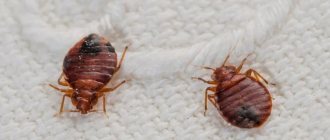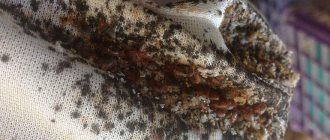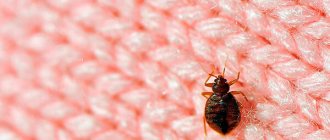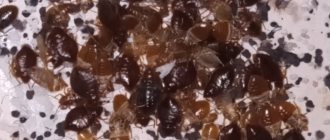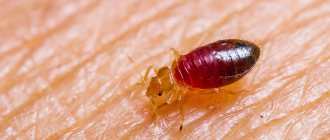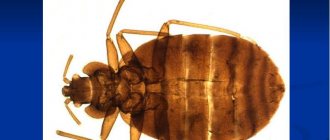What do garden bugs look like?
Almost all bugs living in the garden belong to the stink bug family. This name is explained by the fact that when viewed from above, their body looks like a shield and has a flattened shape. At the same time, the type of garden bugs is diverse. They can be of different sizes - from 0.3 mm to 18 mm. They come in different colors - brown, green, red, etc. There are very bright types, with signal, warning colors. They may have stripes and other patterns on their shell.
The most common types of bugs found in gardens are:
- The green stink bug is the most common pest bug; it has a bright green color and is quite large in size - up to 1.5 cm; feeds on the juice of cultivated plants, prefers raspberry and currant leaves, can also infect herbaceous plants;
- Berry stink bug - this insect has a bright red-brown color, which is due to the fact that this pest sucks juices not only from the leaves of berry bushes, but also from berries; also known as the stink bug because when crushed it emits a pungent and unpleasant odor;
- Cruciferous bug - northern eurydema, a bug that causes great damage to garden plants - cabbage, lettuce, radish, radish; has a bright black and red color;
- The cucumber bug is a pest that destroys the leaves of cucumbers, as well as eggplants, tomatoes, and peppers; It is small in size and brown-green in color;
- The bug is a harmful turtle - outwardly the insect's shell is similar to the shell of a turtle, which explains the name, and the harmfulness lies in the fact that this garden pest destroys cereal crops, and if they are not nearby, it can suck the juices from garden plants; has developed wings, so it can fly long distances;
- Pear laceweed is a very small insect pest that feeds on the sap of fruit plants - apple trees, pears, quince, plums, etc.; This is a brown bug with an openwork pattern on its shell;
- The horse fly bug is a very small gray insect, some subspecies look like ants.
Pest bugs
In addition to the beneficial inhabitants of farmland, household plots and farm fields are also home to pests that cause great damage. Photos and descriptions of the main characteristics of street pests can be seen below.
Pest bugs
- Dressed in a red and black outfit, a representative of cruciferous street bugs is dealing with cabbage plantings. He is helped by the Rapeseed parasite, which has a bright blue-green back with spots and stripes of white. They attack crops of radish, rapeseed and turnips. The provocative coloration serves as protection for street bugs from natural enemies. In case of special danger, they use the ability to emit an unpleasant odor. Special glands endowed with street bugs produce a secretion containing cimycin acid. It creates a disgusting aroma that protects the insect, which is why it is classified as a stink bug.
- The light green stink bug, better known as the berry bug, is a pest that has taken a fancy to raspberry and gooseberry plantings. By autumn, it changes its color to brown, masquerading as fallen leaves. The street bug feeds on the juice of berries, but can also destroy cereal crops. Due to their specific smell, the berries become completely unsuitable for consumption.
- The pest bug is an inconspicuous gray creature, a malicious pest of farmers. The simple pattern on the chitinous shell of the street insect makes it invisible on ripe ears of cereals. Overwintered insects attack young shoots of seedlings, depriving them of the opportunity to develop. The larvae emerge from the eggs during the ripening period of the ear and damage it. The grain becomes unsuitable for making flour and loses its germination capacity. Turtles, along with other pests of cereal crops, have destroyed and rendered unusable more than one field.
Interesting! One chicken released into a field can destroy up to one and a half thousand turtle bugs per day.
Beneficial predator bugs
A number of insects from the order of bugs, on the contrary, are useful in the household. They are even bred specifically to minimize the use of chemicals to protect the crop.
How bedbugs can be useful:
- macrolophus - one of the subspecies of the horse fly bug - eats eggs, larvae and adults of aphids, whiteflies, thrips, spider mites;
- perillus - destroys its natural enemies - Colorado potato beetles, as well as leaf beetles and butterflies;
- Podisus is another predatory bug that destroys caterpillars, butterflies and leaf beetles;
- picromerus is a predatory bug that preys on butterflies, sawflies, Colorado potato beetles, cutworms and other crop pests;
- Soldier bug - feeds on the remains of insects and plants, thereby cleaning the area, and is a sanitarian.
The use of predatory bugs, which are specially bred in biofactories and research institutes, allows us to minimize the use of insecticides and obtain a healthier harvest.
What harm do garden bugs cause?
Garden bugs need plants to feed on. They suck out their juice by making punctures in the leaves, stems, fruits and seeds. After such a puncture, holes remain in the plants, the tissues around them die, and then the entire plant dies. Bedbugs are especially dangerous during the period of plant growth and fruit formation. If the bugs suck the juices from the inflorescences, then there will simply be no fruit. If they feed on the juice of fruits and berries, the latter become unsuitable for food. Bedbugs infect all plants in the garden or vegetable garden - fruits and berries, cereals, cruciferous plants, umbelliferous plants, herbaceous plants, and ornamental plants. The speed of destruction can be very fast. For example, a horse fly bug eats a plant in a matter of hours, so the gardener may not have time to take measures to get rid of pests and protect the crop.
How to get rid of garden bugs
First of all, they need to be detected. If there are suspicions that an area is infested with bedbugs, it is necessary to carry out a visual inspection, paying attention to the back of the leaves on trees and shrubs. In the greenhouse, you also need to carefully examine the back side of the leaves. Clutches of eggs can be located on the leaves, as well as at their junction with the stem.
Traditional methods
Do not neglect traditional methods of controlling garden pests. It can be:
- planting a black cohosh plant - its smell is unpleasant for bedbugs;
- spraying with infusion of onion peels - prepare it at the rate of 250 g of peels per 10 liters of water, leave for 5 days, after which the plants are sprayed once every four days;
- treatment with a solution of laundry soap (300 grams per 10 liters) once a week; You can also dilute wood ash in water along with soap;
- treating plants with a solution of dry mustard every three days.
Traditional methods of fighting bedbugs work, but their disadvantage is their short duration of action. Re-processing of the vegetable garden or garden should be carried out every 3 to 7 days. In this case, each plant needs to be treated, and each leaf must be treated on both sides, since bedbugs can move quite quickly and temporarily wander into weeds or mown grass.
Prevention methods include scattering tobacco dust, dry mustard or hot pepper over the area in the spring, before planting. They will repel or destroy pests, their larvae and eggs in the soil.
Biological method
That is, the use of other insect predators against insect pests. But it is almost impossible to implement this technique on your own, since you need to know exactly what type of bedbugs is to be destroyed and what natural enemies this species has.
Agrotechnical method
To prevent bedbugs from infecting your dacha or garden plot, the following measures must be taken:
- compliance with planting deadlines;
- timely application of fertilizers and loosening of the soil;
- weeding beds;
- clearing the area of fallen leaves, removing grass after mowing;
- maintaining cleanliness in the area.
Timely planting and maintaining the soil in an optimal condition for growing plants makes them more resistant to damage by bugs and other pests. In fallen leaves and mown grass, bedbugs can overwinter or lay eggs. They move from weeds to cultivated plants.
Chemical control method
The most effective way to get rid of garden bugs is to use chemical insecticides. Products containing organophosphorus and pyrethroid substances are suitable. You can use complex preparations to independently destroy garden pests. You can spray the drug "Medilis-Ziper" to destroy bedbugs, mosquitoes, ticks and other pests.
Chemical insecticides act in different ways:
- systemic - penetrate into plants, the insect dies after sucking the juice of such a plant;
- contact - when treating the area, the product gets on the pest, causing it to die;
- intestinal - the bug eats a microdose of poison and dies.
The issue of treating a garden plot with pesticides should only be raised if there is a large infestation of bedbugs. It is necessary to weigh the pros and cons of such treatment, since its results can harm not only the bugs, but also the crop. The use of chemicals is always an emergency measure when other methods of control do not work.
No one is safe from bedbug invasion
It is almost impossible to prevent the appearance of this type of insect in your home. Because many factors of bedbug infestation do not directly depend on humans. The photo below shows bedbug eggs, enlarged. If you look closely, you can see that the surface of the egg is covered with small Velcro hairs. Like burdock, bed bug eggs stick to all fuzzy and porous surfaces. As a result, it is enough to go to visit friends who may have bedbugs in order to pick up several burdock eggs. Or sit on a seat in public transport that was previously occupied by a person living with bedbugs.
There are a lot of options for how you can come into contact with the clutches of this type of insect. It is also difficult to later determine the source of infection, because quite a lot of time passes from the moment the larvae enter the home to the first bite (from 1 to 3 weeks). There is an opinion that bedbugs appear in Moscow due to deteriorating sanitary conditions, but this is not so. In fact, the “cleanliness” in houses and apartments is only improving, because the number of people ready to live in dirt and sewage is decreasing. In fact, the problem is the opposite. Typically, those people who already have bedbugs are careless about the condition of their premises. And the parasites got there due to the fact that in this place there were people in contact with clutches of bedbug eggs.
Very often, bedbugs get into our homes from such careless neighbors, through ventilation, socket boxes, cracks and crevices, in the floor and walls. It’s impossible to keep track of the sanitary situation of your neighbors, isn’t it? You can't protect yourself from this. The only thing that can be done is to put small mosquito nets on the ventilation hatches and fill the cracks and crevices. But this will not 100% protect migrants from neighbors’ bedbugs.
If you have determined for sure that you have bed bugs in your home, do not delay measures to exterminate them. Because once bedbugs get into a room, they will never leave it on their own. You must immediately buy a bedbug repellent or order bedbug disinfestation from specialists. The longer pests have the opportunity to feed and reproduce, the more difficult it will be to eradicate them later.




